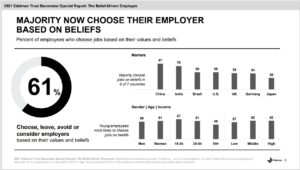From apps to intranets, tech plays a vital role in the success of workplace wellness initiatives
The common must-have for all wellness tech is ease-of-use, says Intel’s Kate Strathdee.

Technology has always been the oil that keeps the engine of organizational communications running, and now, with remote work more common than ever, it’s critical to the success of workplace wellness initiatives. Without reliable, scalable tech platforms that engage employees and integrate into their day-to-day routines, even the best well-being programs will struggle for employee awareness and engagement.
We recently spoke to Kate Strathdee, global HR benefits communication specialist at Intel, about how tech solutions are a critical ingredient in workplace wellness. For Strathdee, Femtech in particular is an area of interest and one in which she’s been doing a lot of research.

Strathdee was a featured speaker at the Workplace Wellness Conference, a virtual event produced on April 21st by Ragan Communications.
Workplace Wellness Insider: What tech has most impacted the workplace wellness realm?
Kate Strathdee: Apps in general. Employees now have access to mental wellness tools in the palm of their hands, when they would historically utilize their health care provider and insurance network. Employees can enroll in counseling or wellness programs using apps. They can either pay out-of-pocket or their employer may provide access. Many of these apps did not exist as recently as five years ago. It shows a growing demand for affordable and easy-to-access mental health care. I would also credit health care reform in the U.S. for expanding mental health coverage over the last 10 years.
WW: What’s still needed for improvement?
Strathdee: In the app space, I’ve been keeping an eye on femtech. It is a huge opportunity for companies to support women, who make up over 51% of the population. Femtech is anything from wearables, to AI, to apps. I’ve seen apps that support parents through pregnancy, women through menopause, and provide chronic illness management and support for conditions like endometriosis. There are also rising venture capital firms founded by women that are investing in technology for women, which is exciting and will help femtech grow over the next few years.
WW: Which technologies produce high engagement?
Strathdee: Comparing some technologies can be like comparing apples and oranges. Both might be delicious, but they’re helpful in different ways. Apps are useful and probably produce more engagement because most people already own a smart phone or tablet. Hardware requires users to adapt their behavior, which in some cases is preferable to the hardware options that already exist.
Here are two use cases: User 1 has anxiety and is seeking mental health support. An app makes sense because it’s easy to use and the user doesn’t need to purchase hardware or learn a new process to receive support. User 2 has a chronic health condition and new technology has been developed for treatment or diagnosis. It could make sense to combine hardware with software in this case. There are companies designing wearable health monitors that fit into clothing, like Bloomer Tech, which is an ECG (electrocardiogram) that fits into bras. Two very different examples. One is more general and the other is more niche, but both show trends in wellness technology.
WW: What are must-have elements for a wellness app?
Strathdee: Wellness apps vary so much by demographic and specialty. For example, mental health apps seem to use different types of therapy or research (many seem to use cognitive behavioral therapy), but the common must-have for all wellness apps is ease-of-use, in my opinion. You can have the best content, but if it isn’t easy to use and intuitive, then users won’t engage. I’ve also seen a few apps in my personal research that don’t update content. We’ve been trained to be entertained by constantly refreshed social media feeds. The companies that seem the most successful offer refreshed content and a variety of topics.






